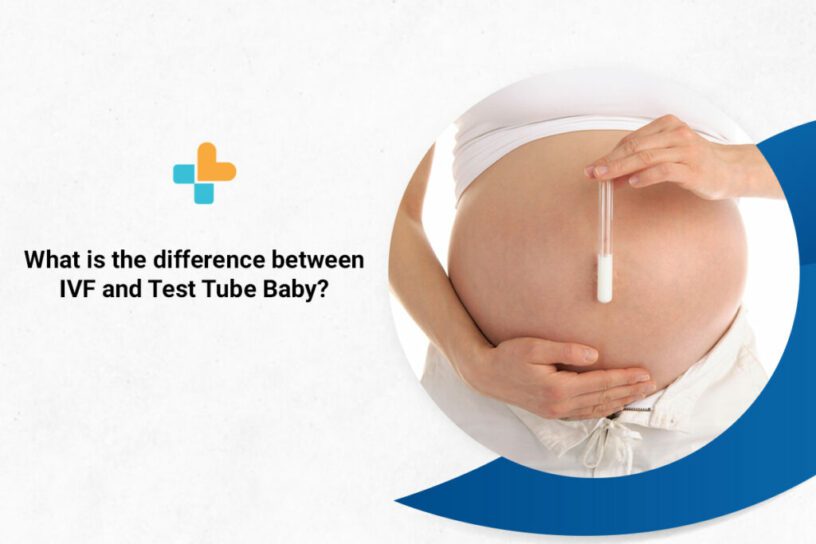Some couples face the challenge to have a child. This can be due to infertility or a damaged fallopian tube. As a solution to this problem new techniques for artificially developing an egg in a glass container were a revolution in the medical field dealing with the human reproductive process. Since approximately 1 in 8 heterosexual couples experiences fertility problems, such parents frequently require medical assistance to conceive.
Additionally, homosexual couples and single parents also require medical assistance to conceive. Given the incredible success rate and technological advancements, there is a growing demand for in vitro fertilization (IVF). People often confuse IVF and test tube babies due to the lack of awareness of the procedure and the fundamental terms of the medications. Here, we will explain what is the difference between IVF and a test tube baby.
What is a test-tube baby?
A child conceived through the process of IVF is called a “test tube baby.” A test tube baby is a baby conceived through in vitro fertilization. Though the colloquial term implies that the babies born through this procedure are produced in a test tube, it is not entirely true. The test tube or petri dish to be precise is where the fertilization process occurs. The fertilized eggs still require a woman’s womb to develop and grow.
The term test tube baby is mostly used in the jargon of common people. With the successful delivery of a child named Louise Joy Brown in England in 1978, the phrase “test-tube baby” became popular. This revolutionized the world of reproductive medicine and was made possible only by the development of the assisted reproduction technique known as in-vitro fertilization (IVF) by visionary scientists Sir Robert Edwards and Dr. Patrick Steptoe. Soon after, in 1983, Prof. S.S. Ratnam, Prof. Ng Soon Chye, the medical director of the Sincere IVF Center, and his staff helped Samuel Lee of Singapore become Asia’s first test tube baby.
Test tube baby process
Numerous improvements have been made to IVF since that initial effort in 1978, but the fundamental process has not changed.
- Stimulative egg production
The woman is provided injectable hormones and fertility medications before egg extraction to encourage the synchronized maturation and advancement of the eggs within her ovaries.
- Egg retrieval
Egg retrieval typically involves transvaginal ultrasound aspiration. A needle is injected via the vagina and into the follicles after an ultrasound probe is used to locate them during this operation. The eggs are extracted from the follicles through the needle, which is attached to a suction tool.
- Fertilization process
Once the eggs are recovered from the follicular fluid, they are transferred to the culture dishes. The culture dishes are placed in an incubator for around 5 to 6 hours before undergoing fertilization. The process of fertilization takes place either by injecting a single fertile sperm into the egg or by mixing the sperm and the eggs in a petri dish. In the case of male infertility, a process called intracytoplasmic sperm injection or ICSI is performed. In the ICSI process, we transfer some of the sperms into a dish where there are drops that are loaded with eggs in a solution that slows down the movement of the sperm. The most vigorous sperm is then injected directly into the egg via a pipette.
Complications
- The drugs used for ovarian stimulation have mild side effects for some women, including mild bruising and soreness at the injection site, headaches, an upset stomach, and mood swings.
- The chances of success, which can be as high as 40% in women under 35, are occasionally increased by doctors transferring multiple embryos simultaneously. Because of this, IVF results in twins and triplets more frequently than natural pregnancies. But these chances can be minimized by medications.
- IVF use can be draining on a person’s body and emotions. You and your partner can get through the ups and downs of infertility treatment with the support of therapists, family, and friends.
What is Vitro Fertilization?
IVF is a method of treating infertility or genetic issues. IVF has been the most effective form of assisted reproduction technology. In IVF procedures, a couple’s sperm and eggs are used in the procedure, but it may also use eggs, sperm, or embryos from known or unidentified donors.
IVF works at mimicking the brilliant design of sexual representation. In patients undergoing IVF, FSH is administered at a level higher than normal, which causes controlled overstimulation of the ovaries to produce multiple eggs. The eggs are retrieved by putting women under anesthesia and using an aspirating needle guided by ultrasound.
Vitro Fertilization process
IVF is a multi-step, challenging process. The procedure should take four to six weeks on average. This covers the time frame in which a person takes fertility medication before egg retrieval and ends with a pregnancy test. Multiple eggs are produced in the ovaries after they have been overstimulated.
When the woman is under anesthesia, the eggs are removed just before ovulation occurs using an aspirating needle guided by ultrasound. In a petri dish, the identified eggs are ready for fertilization. After fertilization, the embryo is further screened for genetic suitability, frozen for later pregnancies, or delivered into the woman’s uterus. There is no difference between IVF and a test tube baby and both these procedures are the same.
Complications with In Vitro Fertilization
- According to research, there is a slight chance that a baby born via IVF will be premature or have a low birth weight.
- When fresh embryos are used for IVF, the rate of miscarriage is similar to that of naturally conceived pregnancies (15–25%), but it rises with maternal age.
- Regardless of the method of conception, the mother’s age is the main risk factor for congenital disabilities. It is necessary to conduct more research to establish whether certain congenital disabilities may be more likely to occur in offspring conceived through IVF.
Test tube baby cost in India
The cost of a test tube baby is significantly lower in India than it is in western nations. The cost can vary based on the region and the complications in egg or sperm production. But the most crucial factor that affects test tube cost in India is the number of cycles required for conception to occur. If you want to get a detailed quote, you can contactAyu Health for detailed information on the process, cost and care required to perform a successful conception.
We offer a wide range of reproductive medicines to support you in your journey to childbirth. We take proper care of your reproductive health care. We offer a spectrum of therapies and treatments to give you and your child the best care necessary. You can reach out to us for consultations regarding improving your health. Then Ayu Health may be your best bet! For booking an appointment, call 636-610-0800.
Our Hospital Locations
Gynaecology Surgery Hospitals in Chandigarh | Gynaecology Surgery Hospitals in Bangalore | Gynaecology Surgery Hospitals in Jaipur | Gynaecology Surgery Hospitals in NCR | Gynaecology Surgery Hospitals in Hyderabad
Our Doctors
Gynaecology Surgery Doctors in Chandigarh | Gynaecology Surgery Doctors in Bangalore | Gynaecology Surgery Doctors in Jaipur | Gynaecology Surgery Doctors in NCR | Gynaecology Surgery Doctors in Hyderabad
About the Author

Dr. Nikitha Murthy B.S.
Dr. Nikitha Murthy B.S. is a renowned Gynaecologist currently practicing at Ayu Health, Bangalore.
He is s a Consultant with IVF Access at its Rajajinagar clinic. She has over 6 years of experience. Dr. Nikitha has a post-graduation (MS) in Gynaecology, DNB from the National Board of India, and a Fellowship in Reproductive Medicine. He also has vast experience in Post-Graduation (MS) in Gynaecology and DNB.




